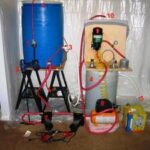Tired of using toxic chemicals to clean and disinfect your home? Not only are they strong-smelling and bad for the environment, but they are also bad for your health. There are plenty of natural and green disinfectants you can make yourself. These are simple to make and easy on you and the environment.
Vinegar as a Disinfectant
Vinegar can be nearly as effective as bleach in killing microbes. In fact, vinegar can be used to increase the effectiveness of bleach. But, since the goal is to be green here, you want to use vinegar alone. As an effective disinfectant, use vinegar full strength. We’re not talking the vinegar you buy at the grocery store. Instead, check with a gardening supplier for full 5% strength.
To clean and disinfect household surfaces with vinegar, put it full strength in a spray bottle. Sprinkle some baking soda over the surface to be cleaned. Then, spray on the vinegar, let it sit for a few moments, and wipe clean. The baking soda/vinegar combination pulls out the soil, the vinegar disinfects, and both help fight odors.
Thyme-Based Homemade Disinfectant
Thymol, found in thyme, is used in many natural cleaning products. It has strong disinfecting power and is also considered an insecticide. Since thyme is a natural product that is often consumed, it is generally safe to use in kitchen areas and even in cleaning baby toys.
To make a cleaning solution, fill a spray bottle with the full strength vinegar mentioned above. Next, add about twenty drops of pure thyme oil and the same amount of pure tea tree oil. Use this homemade green disinfectant to clean kitchen surfaces, baby toys, bathroom surfaces, and more. Simply spray and wipe away.
Harmful Effects of Chlorine Bleach
Chlorine bleach exposure can cause a host of issues and reactions, including death. Exposure to the fumes at a lower level may not cause as much irritation. However, if you are using chlorine bleach indoors and can smell it, that is a good indicator the parts per million (ppm) are too high. A ppm over 0.01 in the air is considered a safe level. Humans can generally not smell the chlorine bleach until it reaches a ppm between 0.02-3.4 ppm. This means if you can smell it, you may be breathing unsafe air.
Short term high exposure may cause chest pains, breathing difficulties, vomiting coughing, excess lung fluid, nose and throat irritation, skin irritation, nausea, and even death. An exposure to air containing 430 ppm can cause death within 30 minutes. Long-term low-level exposure can cause various lung diseases and tooth corrosion. Persons who smoke or have asthma or other respiratory conditions will be at an even greater risk of complications. Effect of chlorine on the environment are still being studied. However, it can adversely affect living organisms in soil and water.
Related Articles from This Author:
Homemade Eco-Friendly Household Cleaners
How to Disinfect and Bleach Laundry Naturally Without Using Chlorine Bleach
Eco-Friendly Stain Removal: Tea
Eco-Friendly Stain Removal: Deodorant
Eco-Friendly Stain Removal: Coffee
Eco-Friendly Stain Removal: Chocolate
Sources:
http://www.purdue.edu/envirosoft/housewaste/src/research.htm
http://www.medicalnewstoday.com/articles/38067.php
http://www.greenschools.net/article.php?id=278
http://www.greenoptions.com/wiki/homemade-cleaner-recipes-and-tips
http://dhs.wisconsin.gov/eh/chemfs/fs/chlorine.htm
http://www.epa.gov/chemfact/f_chlori.txt



